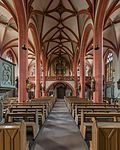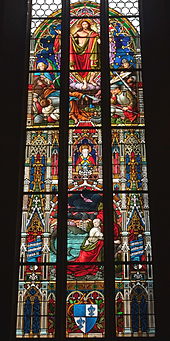St. Andreas (Karlstadt)
The Roman Catholic parish church of St. Andreas in Karlstadt , the district town of the Lower Franconian district of Main-Spessart in Bavaria , was built on the foundation walls of a late Romanesque basilica from the 14th century .
history
From the Romanesque predecessor building, which dates back to the time the city was founded around the year 1200, the former sacristy in the southern choir corner (today the baptistery), the crossing and the west tower have been preserved in today's church, in addition to the wall remains in the nave . From the middle of the 14th century, the transept and choir were built in the Gothic style . The Rieneck Chapel, which is open to the north transept and the choir , was built in 1447, as evidenced by a keystone on the vault with this date . The nave was built around 1481 and vaulted in 1512/13. Around 1583, the Würzburg prince-bishop Julius Echter had the tower increased by one storey and given a new pointed helmet.
Over the centuries the church has been redesigned several times. In 1614 it was painted in the Renaissance style by Wolfgang Ritterlein from Innsbruck . These paintings are still partially preserved on the frames of the portals and on some windows. In the Baroque period , the church received a new interior, which was exchanged for a neo-Gothic one at the end of the 19th century . In the years 1999/2000 the church was renovated again and new furnishings were created.
architecture
West tower
The west tower is structured by pilaster strips and blind arcades. On the ground floor it has a hall that is open on three sides, which is also known as paradise . The second floor is broken up on three sides by two twin arcades, on the third floor a triple arcade opens. The sound arcades rest on slender pillars decorated with capitals . On the west facade of the tower is a copy of a sculpture of St. George , the patron saint of Karlstadt, depicting him as a knight and dragon slayer . The original from the 15th century is kept under the organ gallery.
inner space
The nave has three aisles and is divided into four bays . The Rieneck Chapel, the baptistery (the former sacristy) and the treasury are connected to the transept in the east. The three-bay choir closes with a five -eighth closing . A gallery with a stone parapet is built under the western nave yoke .
The main nave is covered by a ribbed vault, the side aisles have ribbed vaults . St. George , the coat of arms of the Würzburg prince-bishop Lorenz von Bibra and the patron saint of the church, St. Andrew , are depicted on the vault stones of the nave . The keystones of the south aisle show the coats of arms of the noble families of Thüngen , Lichtenstein and Voit von Rieneck , the keystones of the north aisle those of the Hutten and Schauterbach families. The three keystones in the choir are decorated with an eagle, the symbol of John the Evangelist , the Lamb of God and a Christ head with a cross nimbus .
Murals
A wall painting from the 14th century has been preserved in a niche on the south wall of the choir. Here Christ is represented on the cross, under the cross are Mary and John, two angels catch the dripping blood from the wounds of Jesus in goblets. Another painting above the choir stalls shows Mary with the baby Jesus and Saint Joseph . The scene on the opposite wall of the choir shows the adoration of the Magi . The portrayal of St. Christopher is dated to the 15th century.
A wall painting in the south transept, which is dated around 1450, depicts Saint Valentine . Another depiction from the second half of the 15th century has the theme of Gregory's Mass , during which Pope Gregory the Great appears as the Man of Sorrows during Holy Mass .
Leaded glass window
The neo-Gothic leaded glass windows were created between 1876 and 1885 by the Zettler glass painting company in Munich. The central choir window depicts the Coronation of Mary , the side windows are dedicated to the secrets of the Glorious Rosary . On the right-hand side, under the scene of the resurrection of Jesus, the salvation of Jonah from the whale can be seen, under the scene of the ascension of Jesus , one sees the prophet Elias , who drives to heaven with his chariot of fire. On the left, under the Assumption of Mary, the meeting between the Queen of Sheba and King Solomon is shown.
The two windows in the north aisle were originally in the choir and were removed when the new sacristy was built. One window shows the Pentecost scene , the other the Tower of Babel .
pulpit
The church has a late Gothic stone pulpit from 1523 from the workshop of Tilman Riemenschneider . The four reliefs on the pulpit body represent the church fathers Ambrosius , Augustine , Hieronymus and Gregory the Great . They are assigned the symbols of the evangelists Matthew (human figure), Mark (lion), Luke (bull) and John (eagle). On the back wall of the pulpit, Christ is depicted in the midst of vines.
Death lamp
In the north transept is a Romanesque funeral lamp from the early 13th century, which was probably originally placed in the cemetery on the north side of the church. It is monolithic carved from sandstone , with columns decorated with heads set in the corners.
Sculptures
- In the choir is a larger than life sandstone figure of Christ portrayed as Salvator Mundi , which was probably created in Würzburg between 1350 and 1380.
- A cross with a figure of Christ from the 16th century hangs on the ceiling.
- The sculptures stand on the pillars of the central nave:
- Johannes Nepomuk from the 18th century by Anton Herbith
- Saint Valentin , the first bishop of Passau
- Pope Urban
- Wolfgang of Regensburg
- Saint Nicholas
- Saint Barbara
- The figures of St. Francis of Assisi and St. Anthony of Padua in the south aisle date from the 19th century.
- In the north aisle there are the sculptures of St. Stephen (around 1780) and St. Sebastian (around 1800).
- The figure of St. Andrew on the north arch is a copy. The original belonged to the high altar created in 1650, which was demolished in 1875.
- The Pietà in the north transept was created around 1600 by an unknown master.
Further equipment
- The modern altar houses a reliquary that is dated around 1500.
- The silver candlestick with the eternal light above the modern tabernacle was donated in 1739. It is a work of the early Rococo and probably comes from the silversmith's workshop of Abraham Drentwett in Augsburg .
- The font from around 1600 consists of an octagonal basin and is decorated with angel heads and herms .
organ
The organ goes back to an instrument that was built in the years 1683–1684 by the organ builder Johann Jobst Schleich and his journeyman Nikolaus Will. The originally preserved prospectus of the main organ on the west gallery was built by Johann-Jobst Schleich. The painted prospect pipes of the Praestant 8 'are also original and playable. The instrument was rebuilt several times by the organ construction company Weiß in Zellingen . The organ has 64 sounding registers (4,266 pipes) on four manual works and a pedal. The pipes of the Chamadenwerk are on grinding and clay canisters; the rest of the pipes stand on cone ledges. The actions are electro-pneumatic, those of the Chamadenwerk are electric. A special feature of the instrument are the special celesta (glockenspiel with brass bells, c 0 –d 3 in the swell mechanism) and carillon (tube glockenspiel, g 0 –g 2 in the remote mechanism). The organ also has an adjustable cymbal star (8 tones, brass bells) with a visible, rotating star in the main tower of the prospectus; the cymbal star comes from the instrument from 1683/84.
|
|
|
|
|||||||||||||||||||||||||||||||||||||||||||||||||||||||||||||||||||||||||||||||||||||||||||||||||||||||||||||||||||||||||||||||||||
The choir organ on the south-east gallery has 12 stops on two manual works and a pedal. It can be played as a remote control from the fourth manual on the console of the main organ.
|
|
|
||||||||||||||||||||||||||||||||||||||||||
Treasury
Precious works from Augsburg gold and silversmiths' workshops are kept in the treasury. The sculpture of St. George was commissioned from Philipp Jakob Drentwett in 1705 , the figure of Maria Immaculata was created around 1730 in Martin Maurer's workshop.
Rieneck Chapel
The Rieneck Chapel was built in 1447 as a grave chapel for the von Rieneck family . The keystones bear the coat of arms of the Voit von Rieneck family . A keystone is marked with the year 1447. The vault ribs partially rest on consoles carved with heads .
A Gothic Madonna of Bohemian origin is kept in the chapel. The wooden sculptures of St. James , St. Anthony and St. Peter of Milan , dated around 1500, are attributed to the workshop of Tilman Riemenschneider ; the figure of St. Nicholas from around 1505 is considered his own work.
The sandstone retable at the front of the chapel was reassembled from old relief panels. The middle picture dates from 1471 and depicts Christ in torture, surrounded by the instruments of suffering . The names of the donors with their coats of arms are affixed to the bottom right and left. On the left panel Jesus is presented to the high priest , on the right panel Jesus stands before Pilate .
The sculpture of Christ on the scourge column at the passage to the choir was created around 1780 based on the model of the Scourged Savior of the Wieskirche near Steingaden .
Funerary monuments
- The cenotaph of Friedrich von Hutten († 1637) in the south transept was executed in 1727.
- In the Rienecker chapel are the grave monuments of
- Elisabetha Beurin († 1610)
- Christoffel Voit von Rieneck and his two wives Anna von Bibra († 1562) and Ursula Truchsessin von Rügen († 1580)
- Götz Voit von Rieneck zu Greinbach († 1565), his wife and their eight children
- Philipp Voit zu Rieneck († 1550), his two wives Ottilie Voitin von Rieneck and Amalia Voitin von Rieneck and their six children
- Jörg Voit von Rieneck († 1467)
- Barbara Voitin von Rieneck († 1465)
- Philipp Voit von Rieneck († 1504)
- Anna Voitin von Rieneck, née Truchseß von Wetzhausen († 1502)
literature
- Georg Dehio : Handbook of the German art monuments. Francs. The administrative districts of Upper Franconia, Middle Franconia and Lower Franconia . Edited by Tilmann Breuer et al. Deutscher Kunstverlag, Munich 1979, pp. 411–412.
- Klaus Beißwenger: St. Andreas to Karlstadt am Main . Edited by the Catholic parish of St. Andreas, 2nd edition, Kunstschätzeverlag, Gerchsheim 2012, ISBN 3-934223-06-0 .
Web links
Individual evidence
- ↑ Information on the organ ( page no longer available , search in web archives ) Info: The link was automatically marked as defective. Please check the link according to the instructions and then remove this notice.
Coordinates: 49 ° 57 ′ 42.5 " N , 9 ° 45 ′ 56.4" E
















